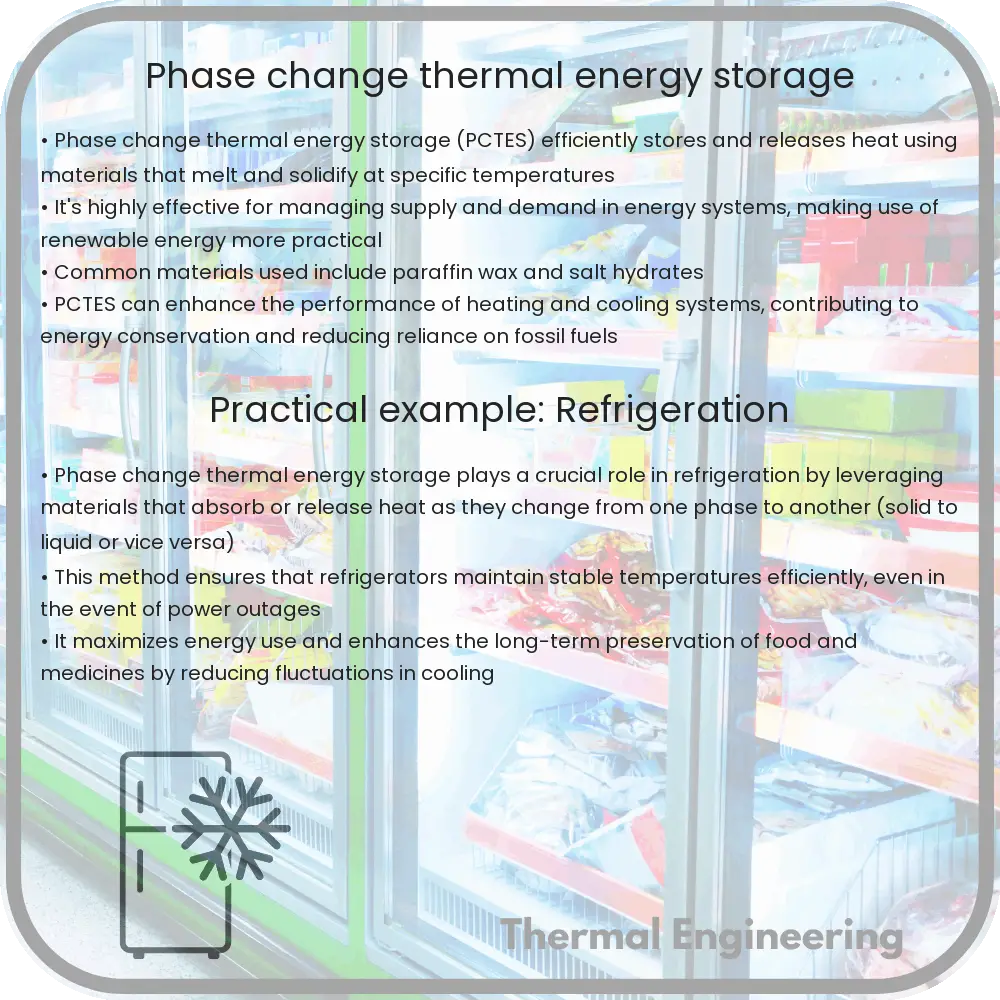Unlock efficient energy management with Phase Change Thermal Energy Storage (PCTES), which leverages latent heat during material phase transitions.

What is Phase Change Thermal Energy Storage?
Phase Change Thermal Energy Storage (PCTES) is a type of thermal energy storage that utilizes the heat absorbed or released during a material’s phase change (e.g., from solid to liquid or vice versa) to store and recover thermal energy. This technology is key in enhancing energy efficiency in various applications, ranging from building heating and cooling to sustainable energy solutions like solar power.
How Does It Work?
The fundamental principle behind PCTES systems is the exploitation of the latent heat properties of phase change materials (PCMs). When a PCM changes its phase, it absorbs or releases a significant amount of energy at a relatively constant temperature. The most common phase change used in PCTES systems is the liquid-solid transition.
For example, during the charging process of a PCTES system, when external heat (e.g., from solar energy or excess electricity) is available, it is used to melt the PCM, thereby storing energy in the form of latent heat. Conversely, during the discharging process, the PCM solidifies and releases the stored energy, which can then be used for heating or other energy needs.
Types of Phase Change Materials
- Organic PCM: Materials like paraffin waxes or fatty acids, which are chemically stable, non-corrosive, and exhibit negligible supercooling and good congruent melting.
- Inorganic PCM: Substances including salt hydrates, which have higher latent heat per unit volume and better thermal conductivity but can undergo phase separation and supercooling.
- Eutectic PCM: Combinations of organic and inorganic materials that melt and solidify at a constant temperature and have a fixed composition.
Applications of Phase Change Thermal Energy Storage
Phase change thermal energy storage finds applications in several fields:
- Building Energy Management: PCTES can be utilized to maintain comfortable room temperatures and reduce the load on conventional cooling and heating systems. PCM materials can be integrated into building structures like walls or floors, or used in HVAC systems.
- Solar Energy Systems: In solar power plants, PCTES can store excess heat generated during the day and release it during the night or overcast periods, thus stabilizing power output and increasing efficiency.
- Waste Heat Recovery: Industrial processes can utilize PCTES systems to store waste heat, which can later be converted into electricity or used in district heating.
Advantages and Challenges
PCTES technology offers numerous benefits:
- High Energy Storage Density: PCMs can store 5 to 14 times more heat per unit volume than sensible heat storage materials.
- Stable Temperature Control: The phase change occurs at nearly constant temperature, providing stability in temperature regulation applications.
- Cost-effectiveness: While initial costs can be high, the high efficiency and durability of PCMs can lead to long-term savings.
However, there are also several challenges:
- Cost of Materials: High-quality PCMs can be expensive, limiting their widespread implementation.
- Integration Complexity: Retrofitting existing systems or integrating PCMTES into new designs requires significant engineering efforts.
- Thermal Conductivity: Most PCM materials have low thermal conductivity, requiring additional engineering solutions to enhance heat transfer rates, such as adding expanded graphite or metal foams.
Conclusion
Phase Change Thermal Energy Storage represents a promising technology that can significantly contribute to the efficiency of thermal systems across various industries. Despite its challenges, ongoing research and technological improvements are making PCTES a viable option for sustainable and efficient energy management.